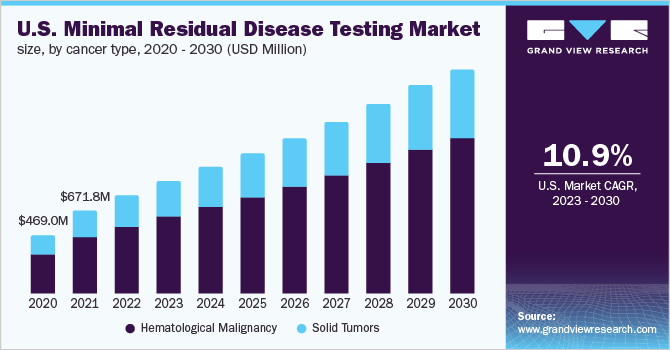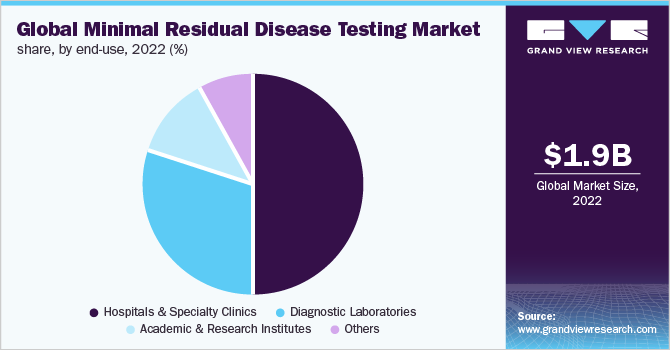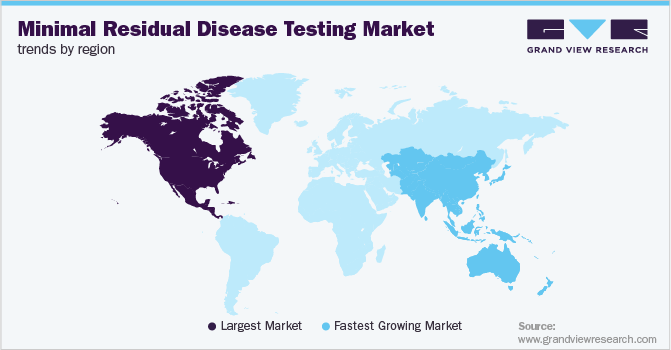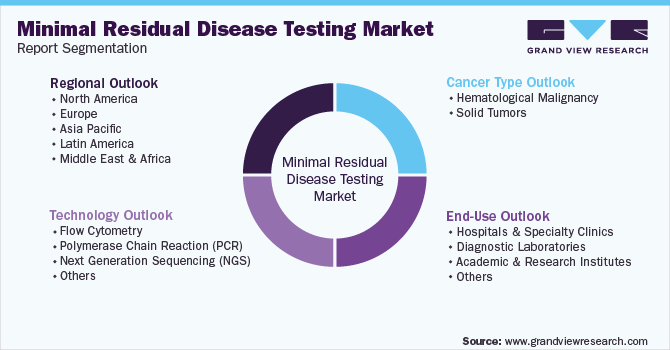- Home
- »
- Pharmaceuticals
- »
-
Minimal Residual Disease Testing Market Size Report, 2030GVR Report cover
![Minimal Residual Disease Testing Market Size, Share & Trends Report]()
Minimal Residual Disease Testing Market Size, Share & Trends Analysis Report By Technology (NGS, PCR), Cancer Type (Hematological Malignancy), By End-use (Hospitals), By Region, And Segment Forecasts, 2023 - 2030
- Report ID: GVR-4-68040-016-3
- Number of Report Pages: 130
- Format: PDF, Horizon Databook
- Historical Range: 2018 - 2021
- Forecast Period: 2023 - 2030
- Industry: Healthcare
Report Overview
The global minimal residual disease testing market size was estimated at USD 1.89 billion in 2022 and is expected to expand at a compound annual growth rate (CAGR) of 11.45% from 2023 to 2030. The minimal residual disease testing market is witnessing growth due to factors such as the increasing prevalence of cancer, increasing consumer awareness for therapy, and increasing funding for research with an increasing disposable income in emerging economies.

Hematologic malignancies are a broad subset of neoplasms that make up a heterogeneous category of tumors. Leukemia, Hodgkin lymphoma (HL), non-Hodgkin lymphoma (NHL), and multiple myeloma are the four most prevalent sub-types of the hematologic malignancies, that are caused due to unchecked proliferation of hematopoietic and lymphoid tissues. Hematologic cancers make up about 6.5% of all cancers and are the fourth most prevalent malignancy to be identified in both men and women in economically developed nations.
The increasing prevalence of cancer is one of the key factors driving market growth over the forecast period. According to WHO, globally, cancer is the second-leading cause of death. In 2020, the incidences of cancer reached 19.3 million, and the number of cancer-related deaths was 9.96 million. According to the International Agency for Research on Cancer, cancer incidence is expected to reach 21.9 million by 2025, and 24.6 million by 2030. This rise in the number of cancer cases is expected to compel governments to initiate new programs for cancer screening of the population.
Furthermore, increasing investments in the field of MRD testing programs are projected to drive market growth. The market has seen increasing research in the field of MRD diagnostics and monitoring which is further propelling the demand for the market. For instance, in January 2021, GRAIL collaborated with top companies for evaluating the ability of Grail’s methylation-based platform for the detection of MRD.
Some of the major challenges associated with the market are the high cost associated with testing and the complex regulatory framework associated with the testing. For drug approval, FDA considers both intended use and associated risks, and clinical & analytical information supporting regulatory submission. Moreover, the average cost associated with the test is over USD 3,500.
Technology Insights
The flow cytometry segment dominated the market in 2022 based on technology. This can be attributed to the high sensitivity and broad applicability of MRD testing offered by flow cytometry. The evaluation of individual cells by flow cytometry involves determining whether specific protein markers are present on the cell surface. Reliable results require a recent bone marrow sample. Special antibodies are applied to the bone marrow sample, and they only bind to cells that have a particular protein on them. According to the flow cytometry configuration, this method can detect one cancer cell out of 10,000 to 100,000 healthy bone marrow cells. The availability of results can be shorter than a day.
The polymerase chain reaction (PCR) technology segment is expected to show lucrative growth during the forecast period. Based on distinctive genetic anomalies, such as mutations or chromosomal alterations, this method can recognize cancer cells. In essence, PCR "amplifies" or enhances" tiny amounts of DNA or RNA fragments to make them more detectable and countable. As a result, PCR can identify genetic anomalies even in the presence of very few cancer cells. Blood cells or bone marrow are used for the test. One cancer cell can be found out of 100,000 normal cells using PCR. The time it may take for test results to be available is between 5 and 14 days.
Cancer Type Insights
The hematological malignancy cancer type segment held the largest market share in 2022. This can be attributed to the increasing use of MRD testing as a diagnostic and monitoring tool in hematological cancers. Hematological malignancies begin in blood-forming tissues or the cells of the immune system. Three main types of hematological malignancies include leukemia, lymphoma, and multiple myeloma. ClonoSEQ assay is FDA approved, for the detection and monitoring of MRD in bone marrow samples for patients with multiple myeloma that uses NGS technology. Moreover, there has been an increasing prevalence of hematological malignancies among the population.
The solid tumors segment is expected to show lucrative growth in the forecast period. This is attributed to the ongoing research being carried out for the assessment of patients with solid tumors. There are currently no approved recommendations in nonhematologic malignancies for use in MRD testing. The application of circulating tumor-derived DNA (ctDNA) as a prognostic biomarker for molecular residual disease (MRD) after therapy for solid tumors is swiftly being included in clinical trial design, and translational research investigations, and is poised to be used in standard clinical care. The poor sensitivity of these detection methods reduces their utility for detecting MRD across a range of clinical applications, even though ctDNA detection technologies have rapidly evolved.
End-use Insights
The hospitals and specialty clinics segment accounted for the largest revenue share in 2022. Hospitals have experts that can assist patients with appropriate MRD test selection. Factors contributing to market growth include increasing prevalence of target condition, availability of multiple testing options, and launch of new tests for better & more effective screening of patients. Moreover, hospital facilities provide better decision-making capabilities that give a better opportunity to doctors and healthcare workers in analyzing and providing better treatment options to patients.

The academic and research institutes segment is expected to show lucrative growth during the forecast period. The growth of the segment is associated with the increasing research activities to determine candidates and established patient diagnoses for research participation is anticipated to drive market growth. In clinical trials, MRD testing for multiple myeloma is increasingly utilized to assess the disease response and as a predictive tool to forecast the length of the response. MRD positivity following treatment is linked to a higher risk of relapse, according to preliminary evidence, while MRD negativity results in increased progression-free survival (PFS). Moreover, studies are being carried out to analyze the relevance of monitoring MRD in patients under treatment sequentially.
Regional Insights
North America dominated the minimal residual disease testing market in 2022, which is attributed to preventive measures undertaken by governments to stop the progression of diseases. In North America, the U.S. and Canada are the two major markets for cancer screening due to high awareness of the benefits associated with screening among patients & physicians. Moreover, several initiatives are being taken to provide MRD testing in the region. For instance, in November 2022, Natera received a National MRD testing contract with the U.S. Department of Veterans Affairs (VA) National Precision Oncology Program for providing MRD and monitoring services with the company’s Signetera MRD test. Furthermore, in February 2022, the Foundation for the National Institutes of Health (FNIH) Biomarkers Consortium (BC) launched a project for validating new methods for quantifying and detecting MRD. The strong MRD reimbursement framework is further enhancing the adoption of testing easier in the region.

Asia Pacific is expected to be the fastest-growing region in the forecast period. Japan is expected to be the major market in the Asia Pacific due to increasing investment in the field of screening and the presence of supportive reimbursement policies. The region also shows a high prevalence of hematological malignancies that requires MRD testing. Key players operating in the market are focusing on research for developing novel tests. Furthermore, the increasing need for monitoring cancer and enabling new MRD solutions is further propelling the growth of the market in the region.
Key Companies & Market Share Insights
The key players operating in the minimal residual disease testing market focus on partnerships, geographical expansion, and strategic collaborations in emerging and economically favorable regions. For instance, in December 2022, Adaptive Biotechnologies Corporation launched the clonoSEQ assay for the detection of MRD in blood for patients with diffuse large B-cell lymphoma. Some of the key players in the global minimal residual disease testing market include:
-
Exact Sciences Corporation
-
GRAIL, LLC
-
Veracyte, Inc.
-
Natera, Inc.
-
Guardant Health
-
F. Hoffmann-La Roche Ltd
-
FOUNDATION MEDICINE, INC.
-
QIAGEN
-
mdxhealth.
-
Bio-Techne.
Minimal Residual Disease Testing Market Report Scope
Report Attribute
Details
Market size value in 2023
USD 2,199.96 million
Revenue forecast in 2030
USD 4.50 billion
Growth rate
CAGR of 11.45% from 2023 to 2030
Base year for estimation
2022
Historical data
2018 - 2021
Forecast period
2023 - 2030
Quantitative units
Revenue in USD million and CAGR from 2023 to 2030
Report coverage
Revenue forecast, company ranking, competitive landscape, growth factors, and trends
Segments covered
Technology, cancer type, end-use, region
Regional scope
North America; Europe; Asia Pacific; Latin America; MEA
Country scope
U.S.; Canada; Germany; U.K.; France; Italy; Spain; Denmark, Sweden, Norway, China; Japan; India; Australia; Thailand, South Korea; Brazil; Mexico; Argentina; South Africa; Saudi Arabia; UAE; Kuwait
Key companies profiled
Exact Sciences Corporation; GRAIL, LLC; Veracyte, Inc.; Natera, Inc.; Guardant Health; F. Hoffmann-La Roche Ltd; FOUNDATION MEDICINE, INC.; QIAGEN; mdxhealth; Bio-Techne
Customization scope
Free report customization (equivalent up to 8 analyst’s working days) with purchase. Addition or alteration to country, regional & segment scope.
Pricing and purchase options
Avail customized purchase options to meet your exact research needs. Explore purchase options
Global Minimal Residual Disease Testing Market Segmentation
This report forecasts revenue growth and provides an analysis on the latest trends in each of the sub-segments from 2018 to 2030. For this study, Grand View Research has segmented the minimal residual disease testing market report based on technology, cancer type, end-use, and region.

-
Minimal Residual Disease Testing Cancer Type Outlook (Revenue, USD Million, 2018 - 2030)
-
Flow Cytometry
-
Polymerase Chain Reaction (PCR)
-
Next Generation Sequencing (NGS)
-
Others
-
-
Minimal Residual Disease Testing Technology Outlook (Revenue, USD Million, 2018 - 2030)
-
Hematological Malignancy
-
Lymphoma
-
Leukemia
-
-
Solid Tumors
-
-
Minimal Residual Disease Testing End-Use Outlook (Revenue, USD Million, 2018 - 2030)
-
Hospitals and Specialty Clinics
-
Diagnostic Laboratories
-
Academic and Research Institutes
-
Others
-
-
Minimal Residual Disease Testing Regional Outlook (Revenue, (USD Million), 2018 - 2030)
-
North America
-
U.S.
-
Canada
-
-
Europe
-
UK
-
Germany
-
France
-
Italy
-
Spain
-
Denmark
-
Sweden
-
Norway
-
-
Asia Pacific
-
Japan
-
China
-
India
-
Australia
-
Thailand
-
South Korea
-
-
Latin America
-
Brazil
-
Mexico
-
Argentina
-
-
Middle East and Africa
-
South Africa
-
Saudi Arabia
-
UAE
-
Kuwait
-
-
Frequently Asked Questions About This Report
b. The global minimal residual disease testing market size was estimated at USD 1,888.38 million in 2022 and is expected to reach USD 2,199.96 million in 2023.
b. The global minimal residual disease testing market is expected to grow at a compound annual growth rate of 11.45% from 2022 to 2030 to reach USD 4.50 billion by 2030.
b. North America dominated the minimal residual disease testing market with a share of 40.47% in 2022. This is attributable to the growing prevalence of hematological malignancies in the region aided with well developed healthcare systems.
b. Some key players operating in the minimal residual disease testing market include Exact Sciences Corporation, GRAIL, LLC, Veracyte, Inc., Natera, Inc., Guardant Health, F. Hoffmann-La Roche Ltd, FOUNDATION MEDICINE, INC., QIAGEN, mdxhealth., and Bio-Techne.
b. Key factors that are driving the market growth include the increasing prevalence of cancer, increasing consumer awareness for therapy, increasing funding for research with an increasing disposable income in emerging economies.
Share this report with your colleague or friend.
![gvr icn]()
NEED A CUSTOM REPORT?
We can customize every report - free of charge - including purchasing stand-alone sections or country-level reports, as well as offer affordable discounts for start-ups & universities. Contact us now
![Certified Icon]()
We are GDPR and CCPA compliant! Your transaction & personal information is safe and secure. For more details, please read our privacy policy.
We are committed towards customer satisfaction, and quality service.
"The quality of research they have done for us has been excellent."





